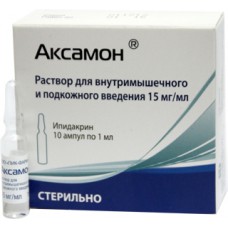Expiration date: 12/2026
Registration number: PL-002247
The trade name of the drug: Axamon®
MNN: ipidakrin
Dosage form: solution for intramuscular and subcutaneous injection
Description: clear, colorless liquid
Composition of 1 ml for a drug concentration of 5 mg/ml:
active substance: ipidakrina hydrochloride monohydrate (anhydrous) 5 mg,
excipients: 0.1 M hydrochloric acid to a pH of 3.00, the water for injection to 1 ml.
Composition 1 ml of preparation with concentration of 15 mg/ml:
active substance: ipidakrina hydrochloride monohydrate (anhydrous) 15 mg,
excipients: 0.1 M hydrochloric acid to a pH of 3.00, the water for injection to 1 ml.
Pharmacotherapeutic group: cholinesterase inhibitor
ATC code: N07AA
Pharmacological properties
Pharmacodynamics. Axamon® is a reversible cholinesterase inhibitor that directly stimulates impulse conduction in nerve-muscle synapses and in Central nervous system (CNS) due to blockade of potassium channels of the membrane. Enhances the action on the smooth muscle not only acetylcholine, but and adrenaline, serotonin, histamine and oxytocin.
Axamon® has the following pharmacological effects:
- improves and stimulates impulse conduction in the nervous system and neuromuscular transmission,
- improves the conductivity in the peripheral nervous system, impaired due to trauma, inflammation, exposure to local anesthetics, some antibiotics, potassium chloride, etc.,
- enhances the contractility of smooth muscle organs under the influence of acetylcholine agonists, adrenaline, serotonin, histamine and oxytocin receptors, with the exception of potassium chloride,
- improves memory, inhibits progradient the development of dementia.
Has no teratogenic, embryotoxic, mutagenic, carcinogenic and immunotoxic action. Does not affect the endocrine system.
Pharmacokinetics. Subcutaneous and intramuscular administration is rapidly absorbed. The maximum concentration in blood is reached after 25-30 min after injection. Linking blood plasma proteins — 40-50 %. The drug rapidly enters the tissues. Metabolized in the liver. Excretion of the drug is via the kidneys (mainly by tubular secretion and only 1/3 by glomerular filtration) and extrarenal (via the gastrointestinal tract). The half-life of the drug Axamon® for parenteral administration is 2-3 hours. After parenteral administration 34,8% of the dose is excreted in the urine unchanged.
Indications for use
• diseases of the peripheral nervous system: mono - and polyneuropathy, polyradiculopathy, myasthenia and myasthenic syndrome of various etiologies,
• diseases of the Central nervous system: bulbar paralysis and paresis,
the recovery period of organic CNS lesions accompanied by motor disturbances,
• atony of the intestine.
Contraindications
Hypersensitivity to any component of the drug, epilepsy, extrapyramidal disorders, hyperkinesis, angina, bradycardia, bronchial asthma, mechanical intestinal obstruction or urinary tract, vestibular disorders, gastric ulcer or duodenal ulcer in the acute stage, children up to age 18 years (there are no systematic data on the use).
With caution in: gastric ulcer and duodenal ulcer, thyrotoxicosis, cardiovascular diseases, obstructive respiratory diseases in history or in acute diseases of the respiratory tract.
If You have one of these diseases, before taking this medication be sure to consult with your doctor.
Use during pregnancy and breastfeeding
The drug increases the tone of the uterus and may cause premature birth, so ipidakrin contraindicated during pregnancy.
Data on the use of drugs during breast-feeding are not available.
Method of application and doses
Subcutaneously or intramuscularly. Dose and duration of treatment is determined individually depending on the severity of the disease.
Diseases of the peripheral nervous system:
• mono - and polyneuropathies of different Genesis, polyradiculopathy: subcutaneously or intramuscularly 5-15 mg 1-2 times a day, a course of 10-15 days (in severe cases up to 30 days), then the treatment continues in tablet form of the drug,
• myasthenia gravis and myasthenic syndrome: subcutaneous or intramuscular 15-30 mg 1-3 times a day with a further shift in the tablet form. The total treatment course is 1-2 months. If necessary, the treatment can be repeated several times with a break between courses of 1-2 months.
Central nervous system diseases
• bulbar paralysis and paresis: subcutaneously or intramuscularly 5-15 mg 1-2 times a day, a course of 10-15 days, then if possible move on to tablet form,
• the recovery period of organic CNS lesions accompanied by motor disorders: intramuscular injection of 10-15 mg 1-2 times daily, course of 15 days, then if possible move on to tablet form.
Treatment and prevention atony bowel: initial dose of 10-15 mg 1-2 times a day for 1-2 weeks.
Side effects
The incidence of adverse reactions that may occur during the use of the drug, as shown in the following classification: very frequent (>,assignments 1/10), common (1/10-1/100 appointments), uncommon (1/100-1/1000 appointments), rare (1/1000-1/10000 appointments), very rare (<,1/10000 destinations), and unknown frequency (frequency cannot be estimated by available data).
Psychiatric disorders: infrequent – drowsiness.
Violations of the nervous system: infrequent: vertigo, headache, convulsions, unidentified frequency – of the tremor.
Violations of the organ: unspecified frequency – cramps.
Disorders of the heart: frequent – palpitations, bradycardia, unidentified frequency, pain behind the breastbone.
Violations of the respiratory system, chest and mediastinum disorders: infrequent – increased secretion of bronchial tubes.
Violations of the gastro-intestinal tract: often – drowsiness, nausea, rare – vomiting, rare – diarrhea, pain in the epigastrium.
Violations of the liver and biliary tract disorders: unknown frequency – jaundice.
Violations of the skin and subcutaneous tissue: infrequent – pruritus, rash.
General disorders injection site: often – increased sweating, infrequent – General weakness, an unknown frequency is hypothermia.
Salivation and bradycardia can reduce m-anticholinergics (atropine, trihexyphenidyl, metacin, etc.).
In case of itching or rash should stop taking the drug. In other cases, reduce the dose or short-term (1-2 days) to interrupt the drug.
If any of the instructions side effects worsen, or You notice any side effects not mentioned in the instructions, inform your doctor.
Overdose
Symptoms: loss of appetite, bronchospasm, lacrimation, sweating, pupillary constriction, nystagmus, increased peristalsis of the gastrointestinal tract, spontaneous defecation and urination, vomiting, jaundice, bradycardia, violation of intracardiac conduction, arrhythmia, lower blood pressure, anxiety, worry, agitation, anxiety, ataxia, convulsions, coma, speech disorders, drowsiness and General weakness.
Treatment: the use of m-holinoblokatorov (atropine, trihexyphenidyl, metacin, etc.), symptomatic therapy.
Interaction with other drugs
Axamon® enhances the sedative effect in combination with drugs, oppressive Central nervous system. Action and side effects increase when used together with other cholinesterase inhibitors and m-holino-mimetic means. In patients with myasthenia increases the risk of a cholinergic crisis, if you apply Axamon® concomitantly with other cholinergic agents. Increases the risk of bradycardia, if, prior to treatment with the drug Axamon® was used ?-blockers. TERS dampening effect on neuromuscular transmission and conduction of excitation along the peripheral nerves of local anesthetics, aminoglycosides, potassium chloride. Axamon® can be used in combination with a nootropic drugs. Alcohol increases the side effects of the drug.
The effect of the medicinal product for medical application on ability to operate vehicles, machinery
During treatment should refrain from driving, other vehicles and mechanisms, as well as from activities potentially hazardous activities, require high concentration and psychomotor speed reactions.
Release form
Solution for intramuscular and subcutaneous administration of 5 mg/ml or 15 mg/ml For 1 ml in ampoules c point or ring fracture of colorless glass. 5 vials are placed in a contour cell package of polyvinyl chloride film. Two contour packaging is placed in a cardboard pack. In each pack put the instructions for use.
Storage conditions
In protected from light place at temperature not exceeding 25 °C. Keep out of reach of children.
Shelf life
2 years.
Do not use after the expiry date.


